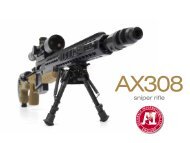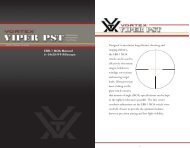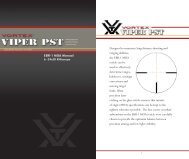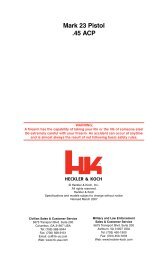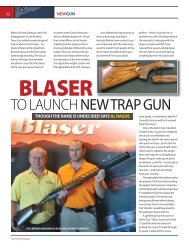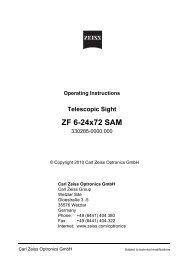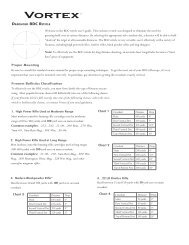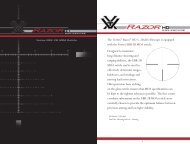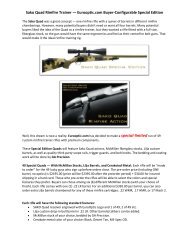You also want an ePaper? Increase the reach of your titles
YUMPU automatically turns print PDFs into web optimized ePapers that Google loves.
For video instructions see our website atwww.deserttacticalarms.comWelcome to the proud family of precision rifle owners. In acquiring your new Hard TargetInterdiction (<strong>HTI</strong>) rifle, you are the owner of the most versatile precision rifle system in theworld. Whether you’re a military marksman shooting a mile or a sportsman shooting 100yards, the <strong>HTI</strong> offers unrivaled flexibility in an overall package.To get the most out of your <strong>HTI</strong> rifle, please read this manual from cover to cover beforehandling and operating the rifle for the first time.WARNING!KEEP OUT OF REACH OF CHILDREN!IT IS DANGEROUS TO ALTER OR MODIFY THIS FIREARM IN ANY WAY. ANY ALTERATIONOR MODIFICATION OF THE FIRING MECHANISM MAY RESULT IN THE FIREARM BECOMINGUNSAFE. ANY ATTEMPT TO ALTER OR MODIFY THIS FIREARM WILL NULLIFY ALL WARRAN-TIES.1
TABLE OF CONTENTS2SAFETY PRECAUTIONS.......................................................................................................4SPECIFICATIONS.....................................................................................................................6FACTS ABOUT THE <strong>HTI</strong>.......................................................................................................8DISASSEMBLY AND ASSEMBLY.....................................................................................13BUTTPAD..............................................................................................................................14BOLT......................................................................................................................................14BARREL................................................................................................................................15MAGAZINE...........................................................................................................................19REMOVING STOCK PANELS.............................................................................................22OPERATING INSTRUCTIONS..........................................................................................23MAGAZINE..........................................................................................................................23LOADING AND UNLOADING...........................................................................................24TRIGGER ADJUSTMENTS.................................................................................................27ADJUSTING CHEEK PIECE...............................................................................................28MOUNTING SCOPE ............................................................................................................ 29QUICK ZEROING.................................................................................................................31
CARE AND CLEANING........................................................................................................37INITIAL CLEANING............................................................................................................38PERIODIC MAINTENANCE...............................................................................................38BEFORE AND AFTER FIRING...........................................................................................42ADDITIONAL DISASSEMBLY & ASSEMBLY.................................................................44BOLT DISASSEMBLY..........................................................................................................44BOLT ASSEMBLY................................................................................................................46IMMEDIATE ACTION AND TROUBLE SHOOTING...............................................49REPAIRS................................................................................................................................55PARTS EXPLODED VIEW...................................................................................................56RIFLE.....................................................................................................................................56BOLT......................................................................................................................................57MAGAZINE..........................................................................................................................58ACCESSORIES........................................................................................................................593
SAFETY PRECAUTIONS4Remember that even the safest gun is potentially dangerous to you and others when it isnot properly handled. Read carefully the operating instructions to learn the proper use andfunctionality of the weapon.Make sure the rifle is unloaded prior to the following:• Receiving or handing over the rifle to another person.• Transporting the rifle.• Cleaning or disassembly.Always remove the magazine immediately after firing and make sure that the chamber isempty. Make sure that the fire selector (safety catch) is on “S” (Safe) position to guaranteethat the rifle is safe whenever:• Inserting magazine.• You have stopped firing the rifle.• The rifle is being transported or moved.• The rifle is not in use.
Before shooting the rifle:• Always wear eye and ear protection.• Always be sure of target backstop and what lies beyond it.CAUTION: MAKE SURE THAT THE BARREL IS FULLY SEATED AND LOCKINGSCREWS ARE TIGHT BEFORE FIRING, AS DESCRIBED ON PAGES 14-18.Do not use excessive force when disassembling or assembling your weapon. Unauthorizedmodifications to the mechanism, damages caused by the application of force, and modificationseffected by third parties will lead to the manufacturer not to assume any liability. Onlya DTA certified armorer is allowed to work on the <strong>HTI</strong> with the exception of the instructionscovered in this owners manual.REMEMBER: ALWAYS ASSUME THAT THE RIFLE IS LOADED: LOOK-ING INTO THE END OF THE BARREL (MUZZLE) IS NOT RECOMMENDEDAT ANY TIME.5
SPECIFICATIONSWEIGHTRifle empty, no accessories .375 CT 19.4 lb. (8.80 kg).408 CT TBA.416 Barrett TBA.50 BMG 18.7 lb. (8.48 kg)LENGTHMinimum Length.375 CT.408 CT.416 Barrett.50 BMGMECHANICAL FEATURESMethod of operation:Method of feeding:Ejection:Bolt ActionMagazineThrough port at right side44 3/4 inch (113.67 cm)44 3/4 inch (113.67 cm)44 3/4 inch (113.67 cm)45 5/8 inch (115.89 cm)6AMMUNITIONCaliber : .375 CT, .408 CT, .416 Barrett, .50 BMG
SIGHTSPicatinny rail (no taper)BARRELTypeMuzzle ThreadsLengthMatch fluted barrel.375 CT: M22x1.5 6G.50 BMG: M25x1.5 6G29 in (73.66 cm)FIRING CHARACTERISTICSMuzzle VelocityVariableMaximum Range2000+yardsSAFETIESFire SelectorSafe and Fire7
FACTS ABOUT THE <strong>HTI</strong>The <strong>HTI</strong> rifle is a lightweight, bolt action operated, magazine-fed firearm. A brief descriptionof the <strong>HTI</strong> rifle follows:8KEY FEATURESAccuracyThe <strong>HTI</strong> sniper rifle maintains exceptional accuracy at extreme distances withqualified ammunition.1. Match grade free-floating fluted barrels2. High quality match trigger3. Repeatable return-to-zero barrel mounting systemQuick caliber conversion capabilityThe <strong>HTI</strong> rifle is available in .375 Cheytac, 408 Cheytac, .416 Barrett, and .50BMG. All cartridges have excellent accuracy at extreme distances and deeppenetration on hard targets. A marksman now has the option to fire highprecision/low-recoil.375 Cheytac and switch to .50 BMG when you need todeliver Armor Piercing, Tracer, or Incendiary payload ammunition.
CompactRuggedThe <strong>HTI</strong>’s bullpup design makes it the most compact and portable Hard Targetrifle in the world. The <strong>HTI</strong> is 12 pounds lighter and 12 inches shorter than theUS M107 .50 BMG rifle currently in service and more accurate.The <strong>HTI</strong> was designed to operate under the harshest conditions and abuse.It utilizes high-impact polymers, aircraft grade aluminum (7075-T6), ultrahigh-strength steels, and durable coatings. The monolithic receiver serves asa full-length mounting chassis, eliminating the need for a bedding interface.Ergonomic stock panels attach directly to the receiver. The <strong>HTI</strong> sustains itsaccuracy and reliability in virtually any environment including subzero arctictemperatures, extreme desert heat and dust, and wet jungle environments.ErgonomicsThe ergonomics and balance of the <strong>HTI</strong> are unmatched. We elected to buildergonomics into the weapon itself, instead of adding heavy accessories as anafterthought.9
Ergonomic Feature List10• Match grade trigger; adjusts for creep, travel, and weight (1 to 6 lb.) and all triggeradjustments can be set without disassembling the rifle.• The padded adjustable cheek piece was designed into the rifles chassis and allows.43 inches (11mm) of adjustment while also providing a protective bufferfrom the shock of larger calibers such as the .50 BMG.• Custom contoured pistol grip• Comfortable rear support grip• Raised butt pad, positions the shooters shoulder above the bore line, minimizingmuzzle rise and felt recoil.• Ambidextrous safety selectors are accessible without removing firing hand frompistol grip.• 60 degree bolt lift• Rear magazine release lever easily facilitates one handed magazine changes sothe shooter can stay on the rifle during magazine changes.• Weapon balancing point is approximately 1 inch forward of the trigger guard.Comfortable carrying grip is located at balancing point.• 14 quick sling attachment points are located on the weapon for shooting versatility.The sling points are also perfectly balanced with the center line of theweapon to ensure the rifle lies comfortably flat when slung.
Other Benefits• The full length MIL-STD-1913 rail facilitates mounting state of the art night visionoptics, thermal sights, and other mounted accessories.• Our magazines incorporate a “shoulder retention” feature that prevents theprojectile tips from hitting the front of the magazine during recoil. In traditionalmagazines the projectile tips slam against the front of the magazine, deformingthe projectile and in turn diminishing accuracy. This can not happen with ourmagazine.• The <strong>HTI</strong> is available in a variety of color configurations; all rifles are hard-coatanodized black and are additionally painted in black, flat dark earth, or olivedrab. The stock panel color options are; black, flat dark earth, or olive drab.General Firearm ConstructionRefer to illustration, (see cover)• The barrel (8) is attached to the receiver (5) by four locking screws (4)• The aluminum hand guard (7) is attached to the front of the receiver (5)• Mil-spec picatinny rails (6) run along the top, bottom and sides of the handguard. Front sling attachment points (1) are located along the bottom and sides11
12of the hand guard (7).• The bolt assembly travels inside of the receiver; the bolt handle (3) is located onthe right side of the receiver (5).• Ambidextrous safety selector (14) is located above the trigger guard, on the rightand left side of the firearm.• The buttpad (11) is attached to the rear end of the receiver (5).
DISASSEMBLY AND ASSEMBLY1. This chapter deals with the disassembly and assembly operations which the usermay perform for routine maintenance of the rifle. Disassembling or assemblingof any other part is not recommended. Any damage caused from improper disassemblywill void warranty.2. Disassembly must be carried out on a clean surface and disassembled partsshould be placed in order of their removal.WARNING: Carry out the following operations before dismantling: Remove magazine;clear the rifle to ensure there is no live cartridge in the chamber (see page 24).CAUTION: FOREARM IS ATTATCHED TO THE RECEIVER.DAMAGE CAUSED BY THE REMOVAL OF THE FOREARMWILL VOID WARRANTY!13
14ROTATING THE BUTTPAD1. Depress the butt pad retaining switch(fig. 1).2. While depressed, rotate the buttpad approximately45 degrees.Figure 1REMOVING BOLT MECHANISM1. Lift bolt handle.2. With the buttpad rotated (fig. 1) slidethe bolt rearward and out of the receiver(fig. 2).Figure 2
REMOVING BARREL1. Remove buttpad and bolt (see page14).2. Using a 5mm hex wrench loosenthe four barrel locking screws (fig.3).Figure 33. Using a 5mm hex wrench rotate thebarrel lock counter clockwise 180˚to unlock (fig. 4).4. Pull out barrel.Figure 415
INSTALLING BARREL1. Ensure the caliber for the bolt matchesthe caliber of the barrel (fig. 5).16Figure 52. Insert barrel into the receiver, note thelocating notch on the barrel extension,position the notch in the six o’clockposition (fig. 6).Figure 6
3. Make sure the barrel is fully seated againstthe feed ramp inside the <strong>HTI</strong> receiver (fig.7).Figure 74. Insert the bolt mechanism into thereceiver (fig. 8). Fully close the bolt,engaging the locking lug in the barrelextension; this establishes head space.Figure 817
185. Using a 5mm hex wrench tighten thefour barrel clamping screws to 80 inch/ lb. of pressure. A torque wrench ishighly recommended for this step toprevent over tightening the lockingscrews (fig. 9).6. Using a 5mm hex wrench rotate thebarrel lock clockwise 180˚ to lock (seefig. 4 on page 15).Figure 9CAUTION: EXCEEDING THE TORQUE SPECIFICATION WHEN TIGHT-ENING THE BARREL LOCKING SCREWS CAN PERMANENTLY DAMAGEYOUR RECEIVER AND WILL VOID ALL WARRANTIES (Portable torquewrenches are available to purchase at our website at www.deserttacticalarms.com orby calling (801) 975-7272).
6. Ease the spring and follower out ofhousing (fig. 11).20ASSEMBLY1. Insert follower with cavity at a 90degree angle through the magazine bottom(fig. 12). Rotate the follower intoposition.Figure 11Figure 12
3. Lock the spring guide into magazineretention tabs (fig. 13).Figure 136. Insert base and push forward untilspring guide button locks into the floorplate (fig. 14).Figure 1421
REMOVING STOCK PANELS221. Place the <strong>HTI</strong> rifle upside down on aclean flat surface. With 4mm and 5mmhex wrenches, remove the screws infront of the trigger guard and inside thehand grip (fig. 15). Lift off the frontsection of the stock panel.Figure 152. Completely unscrew the <strong>HTI</strong> monopod.With a 5mm hex wrench, unscrew thehex screw found in the access holeforward of the monopod (fig. 16).3. Release and rotate the buttpad (seepage 14, fig. 1) and lift the rear stockpanel up.Figure 16
FILLING AND EMPTYING THEMAGAZINE1. With the magazine in an uprightposition and slots facing you, placecartridge on the follower.2. Press down and slide the cartridge rearward(fig. 17).3. Repeat until loaded4. Do not load more than 5 cartridges inthe magazine.EMPTYING1. Push out cartridge with thumb (fig. 18).2. Repeat until magazine is empty.Figure 17Figure 1823
LOADING AND UNLOADINGINSERTING THE MAGAZINESafety OnSafety Off241. Clear the rifle (see page 26).2. Set the fire selector on “S” (Safe) (fig.19).Figure 193. Push the magazine catch lever fowardwhile firmly incerting the magazine.Release the magazine catch lever tofully lock the magazine into position(fig. 20). Above the magazine wellthere is an indicator window that iffully covered with a metal tab yourmagazine is properly incerted.Figure 20
FIRING THE <strong>HTI</strong>1. Never chamber a round until you areready to fire.2. Set fire selector to “F” (Fire) (fig. 19).3. Lift bolt handle and slide it all the wayrearward (fig. 21).4. Run bolt forward and lock into place.5. The rifle is now ready to fire with around chambered.Figure 216. Pull the trigger to fire the gun.7. Repeat step 3. The empty case isejected. If there is another cartridgein the magazine, it will be loaded intothe chamber when running the boltforward. The gun is loaded and ready tofire again.CAUTION: After the last shot is fired the bolt must remain open. Ensure the cartridgechamber is empty!25
UNLOADING (CLEARING) THE <strong>HTI</strong>1. Place the fire selector on “S” (Safe)(see page 24 fig. 19).2. Push magazine catch lever forward toallow the magazine to drop free (fig.22).3. Hold the bolt in the rear position, lookinto the chamber to ensure that thechamber is empty.4. With the chamber empty, close the bolt.5. Place the fire selector on “F” (Fire) andsqueeze trigger with barrel pointing in asafe direction.6. Empty the magazine (see page 23).Figure 2226
TRIGGER ADJUSTMENTSAdjusting Creep1. Insert a 2mm hex wrench through thefront hole in the bottom of the triggerguard into the front screw on the trigger(fig. 23). Turn clockwise to get lesscreep and counterclockwise for morecreep.Figure 23Adjusting Weight Pull2. Using a 2.5mm hex wrench, loosen thescrew on the side of the trigger. Slidetrigger forward or back to the positiondesired then tighten screw (fig. 24).Figure 2427
ADJUSTING CHEEK PIECE1. With an 5mm hex wrench lossen thecheek piece locking bolt until the cheekpiece can move freely. The locking boltis located on the opposite side of thecheek piece (fig. 25).28Figure 253. Set the cheek piece to your desiredheight (fig. 26) and tighten the lockingbolt on the opposite side. The cheekpiece was designed with locking teethso there is no need to over-tighten thelocking bolt.Figure 26
MOUNTING SCOPE1. Identify front of base (fig. 27) (Screwsshould be on right side). Front shouldface the <strong>HTI</strong> muzzle.2. Loosen and remove ring top screws,also loosen the ring base screws but itis not necessary to remove them completely.Figure 273. Tilt base on right side, placing dove tailcatch under picatinny rail (fig. 28).4. Rotate base until flat on top of picatinnyrail. (Ensure left dove tail goesunder rail)5. Tighten base screws to 80 inch lb..Figure 2829
6. Install ring tops.7. Finger tighten ring screws (leave itloose enough that the scope can stillrotate inside the rings) (fig. 29).30Figure 298. Establish eye relief• Get into your favored shooting position• Pull rifle firmly into your shoulder• Close your eyes• Affirm cheek-weld• Open your eyes• Adjust scope forward or backward until any ghost ring goes away (additionalforward or backward adjustment can be gained by moving the entirescope ring base forward or backward along the picatinny rail).
9. Place feeler gauges (and spacer ifnecessary) between bottom of thescope and the flat on ring base (fig. 30).Adjust the feeler gauges until there isa snug fit. This is for the purpose ofmaking the scope flat in relation to thescope base.CAUTION: Take caution when adjusting thefeeler gauges. Do not make fit too tight as damagemay result.Figure 3010. Tighten ring screws to 15 inch/lb., rotating from left to right in a crisscrosspattern. While you tighten, ensure feeler gauges are not too tight. They shouldalways have some left to right play.31
QUICK ZEROING1. Find the center of the scope, place the windage and elevation turret in the centerof the scopes travel range.32• First identify your scopes adjustment values (MOA or MIL).• Determine the total windage and elevation adjustment from the scope’s literature orby turning the knobs from one end to the other while viewing a bore sighter. Note:many scope’s knobs will rotate beyond the erector cells available movement, thusat the extreme ends of the knobs travel, the reticle will stop moving before the knobstops.CAUTION: DO NOT FORCE THE SCOPE KNOBS WHEN YOU REACHTHE END OF IT’S TRAVEL RANGE.• Once total travel has been determined, rotate windage clockwise all the way.• Once windage knob stops, rotate the knob back out in the counter clockwise motionby half of the total windage travel.• Rotate elevation knobs until it bottoms out.• Once bottomed out, rotate the elevation knob back up by half of the total elevationknobs travel.
• Next, identify your scope base taper (20, 30, 40 MOA). Rotate elevation knob downby whichever taper you have.Example:Scope: Nightforce NXS 5-22x50Total Windage=60 MOA= 3022Total Elevation = 100 MOALess the scope base= 50 = 1022taper of 40 MOAThe scopes center is approximately 30 MOA from the edge of the windagetravel and 10 MOA from the bottom of the elevation travel.2. You are now ready to zero.3. You can zero the rifle at any distance you desire. Starting your initial zeroing at25 yards is the easiest method to get on paper. Zeroing at 100 yards requires analert spotter, a good spotting scope, and a large white paper target. If your firstshots are not on the paper try shooting a dirt backstop because shooting dirt ismuch easier to observe than paper.33
344. Once on paper, shoot a three shot group while aiming the cross hairs at the bullseye (fig 31).5. Use crosshairs subtended lines/dots to measure groups distance from bulls eye.You can also measure the distance from bulls eye using a tape-measure, howeveryou will need the conversion formulas (page 36) to change from inches to MOAor MILS. Adjust as per measurements and shoot another 3 shots while aiming atbulls eye (fig. 32).Example: Down 1.6 MilsLeft 1.1 MilsFigure 31 Figure 326. Repeat step 5 until you are satisfied. Note, a rifle shoots at an area not at a singlepoint, so ensure that the center of the group is where your zero is.
SCOPE TURRETS VALUEThe two most common scope adjustment values are Minutes of Angle (MOA) and MilRadians (MILS).1. 1 MOA = 1.047” @ 100 yards2. 1 MIL = 3.6” @ 100 yards3. 1 MIL = 3.438 MOA4. 1 MOA = 0.29 MILSIf you think in terms of inches you must realize that MOA values and MIL valuesare angular measurements, which means that the inch value of both MOA and MILincreases with distance (see illustration below).1 MOA1 MIL100 yds 200 yds 300 yds100 yds 200 yds 300 yds35
It is easier to train yourself to stop thinking in inches and think in terms of MOA andMILS instead. Their values don’t change with distance therefore it will eliminate alot of unnecessary conversion formulas.36Conversion Formulas• Inch to MOA: Inch Value x 100 = MOA CorrectionTarget Distance• Inch to MIL: Inch Value x 100 ÷ 3.6 = MIL CorrectionTarget Distance• MOA to MIL:MOA Value= MIL Correction3.438MIL Value• MIL to MOA: = MOA Correction0.2908
CARE AND CLEANINGGENERALComprehensive knowledge of how to service and handle rifles is of great importance.Experience has shown that most failures which occur while operating the rifle are dueto negligence in maintenance. Special attention must be paid to cleaning, lubricatingand inspecting the rifle; this will determine whether or not the rifle will functionproperly. In order to maintain accuracy, the barrel must be serviced thoroughly. Thereceiver, the bolt assembly and other moving parts of the rifle must be kept clean andlightly lubricated to ensure proper operation. Care and cleaning includes the magazine,which must be kept free from rust, grit, etc., in order to function properly.37
INITIAL CLEANING1. Upon receipt of rifle, disassemble (see page 13) and inspect.2. Clean rifle as per Periodic Maintenance procedure.3. Any heavy or gummy deposits may be removed using very light rust preventiveoils such as Break Free, C.B.C., W.D. 40, or similar. After cleaning, wipe dryand lightly coat with gun oil.4. Never use abrasive or metallic objects, synthetic cloth, dry cleaning fluids, detergents,acids, lye, water or steam.5. Reassemble and make sure the rifle and safeties function properly.6. Observe all safety precautions (see pages 4-5).38PERIODIC MAINTENANCE1. Bore Obstruction: If the bore is obstructed the operator first must determine whatthe obstruction is, where it is located, and how tightly lodged it is in the barrel.NEVER attempt to “shoot out” a bore obstruction as damage to the system mayoccur (as well as possible operator injury). Snow and/or ice can generally bepushed out with a cleaning rod with patch. Should it not be possible to move it in
this manner, it can be warmed until it either melts or loosens sufficiently to allowa push out. Sand, mud and dirt can present a challenge to the operator and caremust be taken to ensure that the bore is not damaged during removal. As muchdebris as possible should be removed by shaking out the barrel (while unloadedand pointed in a safe direction) prior to lubricating the bore with “Break Free”and pushing out with a patch.2. Bore Fouling: Ideally, the bore should be cleaned every 40 rounds in a thoroughfashion utilizing a proper one piece cleaning rod, a jag, a bronze brush, a pullthrough, and cleaning patches to ensure optimum accuracy. Should field conditionsnot allow a cleaning at 40 rounds, the operator can be confident of acceptableaccuracy well beyond this threshold. However a proper cleaning becomescritical to accuracy after 80 rounds has been fired. We suggest the followingprocedure to clean our rifle barrels:• Remove butt pad and bolt (see page 14).• Insert bore guide.• Wet patch with Shooter’s Choice bore cleaner and push through.• Brush thoroughly with sized bronze brush and Shooter’s Choice making atleast two full passes for every shot fired since the last cleaning.39
• Allow to sit for 15 minutes.• Push patch through wet with Shooter’s Choice.• Patch with 4 dry patches or until patches come out dry and clean.• Run patch through bore wet with Sweet’s 7.62 bore solvent and let sit forNO LONGER than 10 minutes.• Patch with a clean dry patch. If there is blue residue on the patch, repeatthe cleaning process until no blue residue remains on the final stage.• Once the bore is clean, utilize the pull through with patch saturated withShooter’s Choice in a back and forth motion for 10 strokes.• Push through 4 dry patches or until patches come out dry and clean.403. Muzzle Brake: Ensure that the vents are clear of debris and occasionally checkto ensure the brake has not “shot loose”.4. Magazine: It is imperative that the magazine be given the best of care and keptin perfect condition. They should be disassembled, cleaned, and lightly oiled(see pages 19-21). Check magazine lips. They should not be deformed, nicked,or cracked.
5. Receiver Interior: A visual and manual inspection of the inside of the receiverwill reveal what, if any cleaning is necessary. Most debris can be removed witha cloth, cleaning patch, or cleaning brush.6. Bolt Face: Ensure that the bolt face is free from debris that will create headspace,chambering problems, and/or inhibit function of either the extractor orejector. This area can be wiped clean or blown out. This is also a good time toensure that the ejector and the extractor are functioning properly by manuallyactuating them to ensure proper spring function and return. Also, a small amountof Break Free may be applied to the bolt face area at this time.7. Bolt Interior: The operator should occasionally remove the firing pin assemblyfrom the bolt (see pages 44-48). Wipe this area clean prior to applying a smallamount of Break Free.8. General Cleaning: The entire rifle should be wiped off with a clean cloth lightlysaturated with Break Free on occasion. This includes the barreled action, scoperings, and ancillary components.41
BEFORE AND AFTER FIRINGCLEANING BEFORE FIRING1. Disassemble the rifle (see page 13).2. Run clean patches through bore and chamber to remove all dust and oil. Thereshould be no oil in the bore or chamber before firing as this may cause dangerouspressures to develop.3. Remove excess oil from interior of the bolt and bolt face.4. Check that all moving parts are lightly oiled.5. Assemble the rifle and check functioning (see page 13).42CLEANING AFTER FIRING1. The rifle should be cleaned no later than the evening of the day on which it wasfired to prevent corrosion and caking of deposits.2. Follow procedures of periodic maintenance and pay particular attention to allparts which have been in contact with powder gases.• Barrel: In order to remove heavy deposits, use cleaning brush. Make surethe brush goes all the way through the bore before reversing the direction.
Deposits that cannot be readily removed with the brush may be treated bycoating the bore and chamber with good quality bore & chamber fluid andallowing to soak for at least twelve hours.• After soaking: repeat above procedure. The barrel should be cleaned and reoiled,at least once on the day after firing.• Firing Mechanism: Remove all powder residues from bolt face and interiorsurfaces of the bolt. If necessary, use stiff nylon brush or tooth brush.• Receiver: Wipe off any heavy deposits in the interior and oil lightly.• Magazine: Make sure the magazine/s are clean and the follower movesfreely.43
ADDITIONAL DISASSEMBLY & AS-SEMBLYBOLT DISASSEMBLY1. Hold the bolt with the end cap facingaway and with your left thumb, push onthe striker tab toward the bolt handle(fig. 33).2. Using secure table or bench, hook thestriker tab on the underside, pulling thebolt away from the table while turningthe bolt counter-clockwise (fig. 34).The end cap is under pressure due tothe firing pin spring. Be aware, it willshoot out on to the floor. To avoid thisfirmly place your left index finger overthe endcap while removing it.WARNING: THE FIRING PIN SPRING IS UN-DER COMPRESSION! TAKE CAUTION WHENREMOVING THE END CAP!Figure 33Figure 3444
3. After retrieving the firing pin springand end cap, remove the bolt sleeve andstriker (fig. 35).Figure 354. Remove firing Pin (fig. 36).Figure 3645
BOLT ASSEMBLY1. Insert the firing pin into the bolt (fig.37). Make sure the pin protrudes out theend of the bolt.46Figure 372. Insert the striker inside the bolt sleeveslot with the striker tab facing out thenslide the striker and bolt sleeve onto thebolt (fig. 38).Figure 38
3. Make sure the striker is seated to theright of the striker slot (fig. 39).Figure 394. Insert the firing pin spring into thestriker and place the end cap on topof the spring and striker, making surethe slot in the end cap slides over thestriker tab (fig. 40).Figure 4047
5. Hold the bolt with the end cap facingaway and with your thumb hold thestriker tab steady. Push the end capagainst a secure table or bench until theend cap is fully engaged, then twist thebolt clockwise until the striker tab fallsinto the striker slot (fig. 41).48Figure 41WARNING: THE FIRING PIN SPRING IS UNDER COMPRESSION! TAKECAUTION WHEN INSTALLING THE END CAP!For video instructions on bolt disassembly and reassembly visitwww.deserttacticalarms.com
IMMEDIATE ACTION AND TROUBLE SHOOTINGA failure to fire (including one caused by an empty magazine) may often be correctedby taking immediate action.IMMEDIATE ACTIONRemove magazine and wait 3 seconds with barrel pointing in a safe direction, theninspect magazine.1. MAGAZINE EMPTYCock to remove possible last round. Inspect the chamber and if empty, inserta full magazine, run the bolt and continue firing.49
2. MAGAZINE NOT EMPTY (Malfunction)• Open the bolt and if a round or case ejects, inspect chamberand clean the round that misfired. If empty, reload andcontinue firing.50• If nothing ejects, fully draw back bolt and check if acartridge or case is in the chamber. If empty, reload andcontinue firing.• If base of cartridge is visible, close bolt and fire in a safedirection. If rifle fires and ejects, reload and continue.• If rifle does not fire, set fire selector on “S” (Safe) and follow“spent case or round stuck in chamber” (see page 54).
TROUBLE SHOOTINGA. FAILURE TO FEEDCAUSE1. Incorrect Cocking2. Poor Magazine3. Magazine Improperly Seated4. Magazine Improperly Loaded5. Dirty Magazine6. Damaged Magazine7. Double Feed* Rifle jams or closes on empty chamberREMEDYClear jam if necessary and run bolt.Replace with DTA factory magazine.Push magazine home until latch catches.Check that no more than 5 rounds are in the Magazine.Disassemble and Clean.Replacea. Inspect for stuck case or cartridge (see sectionE. on page 54).b. Check extractor and ejector (see section D.on page 53).51
B. FAILURE TO CHAMBER * Bolt does not fully close and rifle will notfire.52CAUSE1. Incorrect Cocking2. Dirty Chamber3. Defective Ammunition4. Very dirty rifleREMEDYRemove magazine. Re run the bolt and reload.Clean.Check for damaged cartridges.Check to see if the bolt and firing mechanism issluggish. Clean and oil if necessary.C. FAILURE TO FIRE * Striker assembly snaps home but rifle willnot fire.CAUSE1. Bolt not Fully Closed2. Defective CartridgeREMEDYFollow procedure for incorrect cocking or shortrecoil.Inspect primer. If fully indented discard safely.If not fully indented, check firing mechanism.
3. Dirty Firing Mechanism Check to see if operaion is sluggish.4.5.6.Defective Firing PinDefective Striker AssemblyBarrel Not Properly SeatedClean and replace as necessary.Clean and replace as necessary.Make sure the locating notch on the barrelextension lines up with the feed ramp of thereceiver and is fully seated (see pages 16-18).D. FAILURE TO EXTRACT OREJECTCAUSE1. Overpowered Ammunition(Stuck Case)2. Dirty or Damaged ChamberThe fired case may not eject, or the riflemay jam (spent case left in chamber).REMEDYCheck ammunition and change to a differentbrand of currently commercially manufacturedammunition if problem persists.Inspect, clean, replace barrel if necessary.3. Defective Ammunition Check ammunition for damage. Replace ifproblem persists.53
4. Fouled Extractor5. Extractor Defective or Missing6. Damaged EjectorClean Extractor.Replace.Replace if necessary.54E. SPENT CASE OR ROUND STUCK IN CHAMBERCaution: The following procedure should be carried out only after following thesteps in “Immediate Action” (see page 49).1. Remove bolt and striker assembly.2. With barrel in place, insert cleaning rod through front of barrel. Push or tapgently to remove obstruction.3. Check chamber and bore. Clean before reassembly.4. If obstruction cannot be removed, disassemble barrel and contact a certified DTAArmorer.
REPAIRSREPLACING FIRING PIN1. Disassemble the bolt (see pages 44-45)2. Insert new firing pin3. Assemble the bolt (see pages 46-48)STORAGEWARNING!KEEP OUT OF REACH OF CHILDREN!IT IS DANGEROUS TO ALTER OR MODIFY THIS FIREARM IN ANY WAY.ANY ALTERATION OR MODIFICATION OF THE FIRING MECHANISMMAY RESULT IN THE FIREARM BECOMING UNSAFE. ANY ATTEMPTTO ALTER OR MODIFY THIS FIREARM WILL NULLIFY ALL WARRAN-TIES.55
PARTS EXPLODED VIEW<strong>HTI</strong>56BarrelBoltReceiverForearmTrigger and SafetyStock PanelGrip and Trigger GuardButtpadMonopodMagazine
BOLTEnd CapFiring PinSpringBolt SleeveStrikerFiring PinBoltExtractorSpringExtractorDetente ExtractorEjectorSpringEjectorEjectorRoll Pin57
MAGAZINE58Floor PlateFollowerMagazine HousingSpringGuideSpring
ACCESSORIESDay ScopesNight VisionTapered Scope ringsSuppressorHard CaseRifle Matt CarrierMagazinesBipods and AdaptersSlingsRail CoversField Cleaning KitBench Cleaning KitToolsSpare parts kitArmorer ToolsScope Installation & Zeroing Kit59
PATENTS PENDINGNo part of this document may be copied, reproduced, or transmitted by any means, for anypurpose without permission from <strong>Desert</strong> <strong>Tactical</strong> <strong>Arms</strong>, Inc. All images and text © 2008-2009 DTA, Inc.60LIMITATION OF LIABILITYThe liability of <strong>Desert</strong> <strong>Tactical</strong> <strong>Arms</strong>, Inc. for any and all losses/and or damage to thepurchase shall in no event exceed the purchase price of the Rifle. In no event shall <strong>Desert</strong><strong>Tactical</strong> <strong>Arms</strong>, Inc. be liable for incidental or consequential damage. User assumes all risksand liabilities arising from the use of this product.
PO Box 65816Salt Lake City, Utah 84165Phone (801) 975-7272 Fax (801) 908-6425www.deserttacticalarms.comTM



